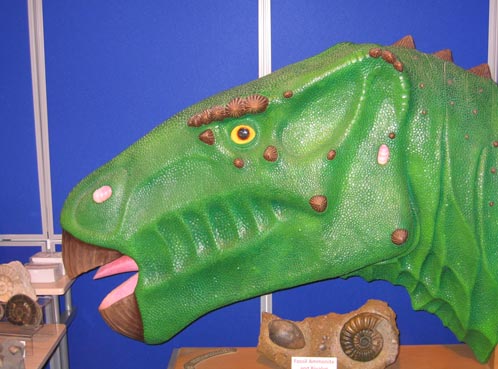Meeting an Iguanodontid in Birmingham
After the news story which we featured last year regarding the discovery of an iguanodontid fossil found in a Sunderland garden, I suppose we should be used to having elements of the Ornithopoda turning up in unusual places. However, team members at Everything Dinosaur were still a little surprised to come across a life-size model of the head of an Iguanodon (we suspect I. bernissartensis), whilst visiting a trade show in the West Midlands.
Iguanodon Makes an Impression at Trade Show
Picture credit: Everything Dinosaur
We met the charming Martin Simpson, a passionate fossil collector, who with his colleague, told us all about their amazing ammonite and fossilised lobster collection. Martin, lives on the Isle of Wight, this island off the south coast of England is often referred to as the “Dinosaur Isle”. The Lower Cretaceous strata that is exposed on some parts of the island has yielded a number of important vertebrate fossil finds including a number of Dinosauria. Known locally as the “Fossil Man”, Martin has been involved with a number of recent fossil discoveries and we discussed his work on a new genus of pterosaur that had been discovered on the Isle of Wight.
Iguanodon
Some of Martin’s collection is available for sale, so if you have fancied owning a part of the Cretaceous fauna, check out his website; appropriately called: Island Gems.
Martin has promised us that he will pass onto us some more information about the Isle of Wight flying reptile discovery, no doubt we will get the chance to publish more details in this blog.
Always a pleasure to see such wonderful fossils and to talk with fellow enthusiasts.
To read about the Sunderland Iguanodontid: Strange Place to Find an Iguanodontid.







For years now, I have wanted to put in my two cents worth regarding Iguanodon’s spikey thumb. It is usually described as a defensive weapon, but I think that it is analogous to a telephone or hydro lineman’s pitons or climbing spikes. That is, when rearing up to browse on tall trees, Iguanodon jammed that thumb/spike into the trunk of the tree, to support its heavy body while plucking leaves and branches with the claws of the other forefoot. From time to time, it might switch to the other forefoot when it tired.
I would be thrilled out of my mind if someone would respond to this notion! Anyone???
It is an interesting theory, it was once thought that Hypsilophodonts, (Ornithopods like Iguanodon could climb trees and that they were arboreal), this theory has now been largely discounted, however, since no one has actually observed a living Iguanodontid it is very difficult to say with complete certainly how the thumb spike was used. The first interpretations placed this spike on the nose, we now know that this is incorrect. The fingers of Iguanodontids seem to have been quite dextrous, the thumb spike may not have been able to support the weight of an adult in the way you described but juveniles could well have used their spikes to help them climb trees to escape a predator, although we tend to think that these animals spent all their time on the ground. The thumb spike could have had a number of uses, for example it would have made an effective weapon, but it might also have been used to scrap bark of trees or to rip open cycads thus permitting this herbivore easier access to the fronds on the top of the cycad plants. It may have been used to help this animal to feed.